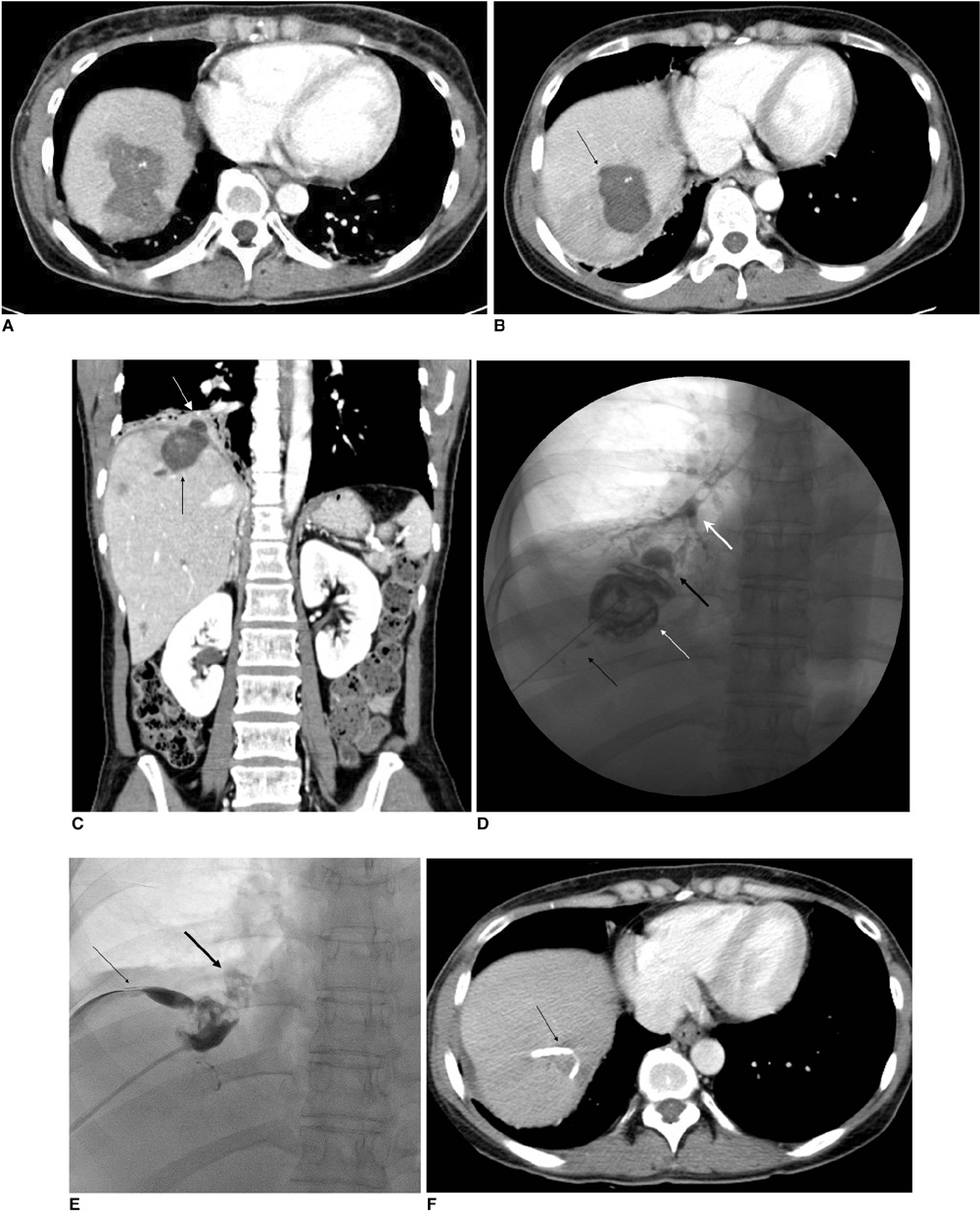Korean J Radiol.
2009 Aug;10(4):411-415. 10.3348/kjr.2009.10.4.411.
Percutaneous Management of a Bronchobiliary Fistula after Radiofrequency Ablation in a Patient with Hepatocellular Carcinoma
- Affiliations
-
- 1Department of Internal Medicine, Asan Medical Center, University of Ulsan College of Medicine, Seoul 138-736, Korea. kimkm70@amc.seoul.kr
- 2Department of Radiology, Asan Medical Center, University of Ulsan College of Medicine, Seoul 138-736, Korea.
- KMID: 1777272
- DOI: http://doi.org/10.3348/kjr.2009.10.4.411
Abstract
- Radiofrequency ablation (RFA) is a minimally invasive, image-guided procedure for the treatment of hepatic tumors. While RFA is associated with relatively low morbidity, sporadic bronchobiliary fistulae due to thermal damage may occur after RFA, although the incidence is rare. We describe a patient with a bronchobiliary fistula complicated by a liver abscess that occurred after RFA. This fistula was obliterated after placement of an external drainage catheter into the liver abscess for eight weeks.
Keyword
MeSH Terms
Figure
Cited by 2 articles
-
Two cases of bronchobiliary fistula: Case report
Jae Ryong Shim, Sung-Sik Han, Hyung Min Park, Eung Chang Lee, Sang-Jae Park, Joong-Won Park
Ann Hepatobiliary Pancreat Surg. 2018;22(2):169-172. doi: 10.14701/ahbps.2018.22.2.169.Surgical treatment of bronchobiliary fistula due to radiofrequency ablation for recurrent hepatocellular carcinoma
Dong Hun Kim, Dong Wook Choi, Seong Ho Choi, Jin Seok Heo, Jaehong Jeong, Jinsoo Rhu
Korean J Hepatobiliary Pancreat Surg. 2013;17(3):135-138. doi: 10.14701/kjhbps.2013.17.3.135.
Reference
-
1. D'Altorio RA, McAllister JD, Sestric GB, Cichon PJ. Hepatopulmonary fistula: treatment with biliary metallic endoprosthesis. Am J Gastroenterol. 1992. 87:784–786.2. Warren KW, Christophi C, Armendariz R, Basu S. Surgical treatment of bronchobiliary fistulas. Surg Gynecol Obstet. 1983. 157:351–356.3. Khandelwal M, Inverso N, Conter R, Campbell D. Endoscopic management of a bronchobiliary fistula. J Clin Gastroenterol. 1996. 23:125–127.4. Deshmukh H, Prasad S, Patankar T, Patel V. Percutaneous management of a broncho-biliary fistula complicating ruptured amebic liver abscess. Am J Gastroenterol. 1999. 94:289–290.5. Tran T, Hampel H, Qureshi WA, Shaib Y. Successful endoscopic management of bronchobiliary fistula due to radiofrequency ablation. Dig Dis Sci. 2007. 52:3178–3180.6. Tateishi R, Shiina S, Teratani T, Obi S, Sato S, Koike Y, et al. Percutaneous radiofrequency ablation for hepatocellular carcinoma. An analysis of 1000 cases. Cancer. 2005. 103:1201–1209.7. Liberale G, Delhaye M, Ansay J, Houben JJ, Coppens E, Gelin M, et al. Biliary pleural fistula as a complication of radiofrequency ablation for liver metastasis. Acta Chir Belg. 2004. 104:448–450.8. Kim YS, Rhim H, Sung JH, Kim SK, Kim Y, Koh BH, et al. Bronchobiliary fistula after radiofrequency thermal ablation of hepatic tumor. J Vasc Interv Radiol. 2005. 16:407–410.9. Mulier S, Mulier P, Ni Y, Miao Y, Dupas B, Marchal G, et al. Complications of radiofrequency coagulation of liver tumours. Br J Surg. 2002. 89:1206–1222.10. Pende V, Marchese M, Mutignani M, Polinari U, Allegri C, Greco R, et al. Endoscopic management of biliopleural fistula and biloma after percutaneous radiofrequency ablation of liver metastasis. Gastrointest Endosc. 2007. 66:616–618.
- Full Text Links
- Actions
-
Cited
- CITED
-
- Close
- Share
- Similar articles
-
- Surgical Treatment of Bronchobiliary Fistula with Pulmonary Resection and Omentopexy
- Surgical treatment of bronchobiliary fistula due to radiofrequency ablation for recurrent hepatocellular carcinoma
- Successful percutaneous management of bronchobiliary fistula after radiofrequency ablation of metastatic cholangiocarcinoma in a patient who has a postoperative stricture of hepaticojejunostomy site
- Small Bowel Perforation after Percutaneous Ultrasound-guided Radiofrequency Ablation of Hepatocellular Carcinoma
- Completely Ablated Hepatocellular Carcinoma by Percutaneous Radiofrequency Thermal Ablation


